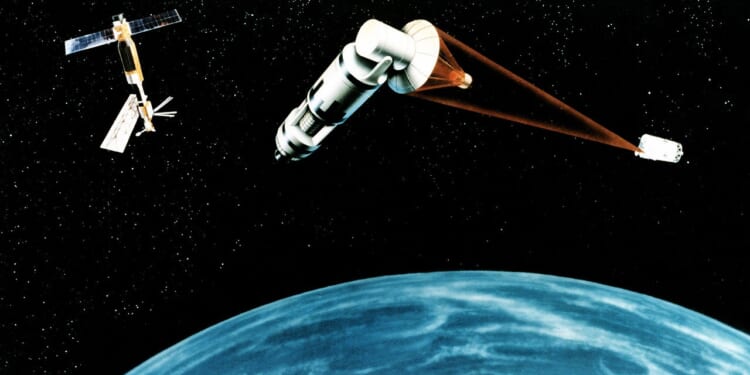The Strategic Defense Initiative, or “Star Wars,” was far too ambitious for the technology of its era—but its programs live on in various US air defense efforts.
Perhaps the most famous weapons system that never existed, President Ronald Reagan’s Strategic Defense Initiative (SDI), popularly known as “Star Wars,” was conceived as a grand solution to the nuclear stalemate of the Cold War. Announced with great fanfare in 1983, SDI aimed to render incoming nuclear weapons impotent through the construction of a defensive shield around the United States that could shoot down incoming Soviet missiles before they struck American cities.
SDI was a bold and visionary idea that captured the imagination of the American public—and inspired fears of obsolescence amongst Soviet strategists. But SDI was technologically too bold and too visionary; the project was decades ahead of its time, and from a purely scientific-industrial standpoint, it was impossible to create in the 1980s.
SDI’s Plan for Layered Air Defense
SDI was intended to be a layered missile defense system that spanned Earth and space itself. The architects of the system envisioned multiple lines of interception, including space-based lasers that could strike Soviet missiles during their boost phases; orbiting interceptor satellites to collide with warheads in their midcourse; and ground-, or sea-based missiles to mop up any weapons that slipped through the preceding layers.
Complementing the various layers of SDI would be a global network of radars, infrared sensors, and command computers that were to track thousands of fast-moving targets across continents and oceans. The entire, complex system would operate at the speed of light, reacting in seconds to detect, classify, and destroy intercontinental ballistic missiles (ICBMs) launched from anywhere on Earth.
The Soviets—and Some Americans—Were Terrified of SDI
The strategic implications of SDI would have been profound. Although the Reagan administration framed the program as defensive in nature—solely designed to shoot down incoming missiles, not launch its own—it upended the prevailing doctrine of Mutually Assured Destruction (MAD), which had defined nuclear deterrence for decades.
Under MAD, both the United States and the Soviet Union accepted that any nuclear war would be an existential event. After all, each side had the quantity and diversification of weaponry to guarantee annihilation of their opponent. Perhaps counterintuitively, this made nuclear war impossible: there was no way to win one without suffering annihilation, so one could never be fought.
But if the United States had a shield that could defend it from incoming nuclear projectiles, the prevailing logic fell apart. If SDI worked, the United States could launch a nuclear attack on Moscow at any time, safe from retaliatory warheads from the Kremlin.
Reagan found the cold logic behind MAD unacceptable, and wanted to use technological improvements to allow America to physically defend itself, rather than rely solely on the threat of retaliation. Doing so, in his mind, would allow the US to move past deterrence to achieve true security. To Reagan’s supporters, SDI was a visionary use of science to preserve civilization. But to Reagan’s critics, SDI was a dangerous escalation in the Cold War—and, moreover, a Hollywood-adjacent science fiction boondoggle for the Pentagon.
The SDI Project Was Far, Far Ahead of Its Time
SDI had a practical problem: the technology to make it real did not exist. Space-based lasers would have required immense power sources, precision tracking, and near-perfect reliability to destroy missiles within seconds of launch. Likewise, interceptor satellites needed real-time computing and guidance accuracy that no existing system could deliver. Moreover, adversaries could easily overwhelm or confuse the SDI system with decoys, multiple warheads, or sheer numbers of missiles. And even if SDI were successful in intercepting 90 percent of an incoming warhead volley—which was a highly optimistic figure—the remaining 10 percent would still cause a biblical cataclysm.
By the early 1990s, the technical limitations of SDI were clear. When the Soviet Union collapsed and the Cold War ended, Congress slashed defense funding, and the SDI program faded away. But the legacy of its ambition endured. Many SDI-related research programs evolved into today’s real-world missile defense systems, including the Aegis Ballistic Missile Defense, THAAD, and Ground-Based Midcourse Defense—all of which can trace their conceptual lineage to SDI’s ambition of hit-to-kill interception and integrated sensor networks. And the vision of a defense grid protecting the United States from aerial attack has lived on in President Donald Trump’s proposed “Golden Dome,” an ambitious air defense project that, much like Star Wars, may or may not pencil out in the years to come.
About the Author: Harrison Kass
Harrison Kass is a senior defense and national security writer at The National Interest. Kass is an attorney and former political candidate who joined the US Air Force as a pilot trainee before being medically discharged. He focuses on military strategy, aerospace, and global security affairs. He holds a JD from the University of Oregon and a master’s in Global Journalism and International Relations from NYU.
Image: Wikimedia Commons.


















